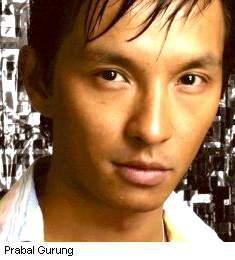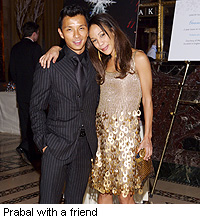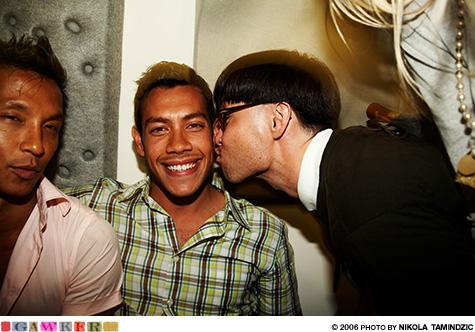Here's someone who did not follow the herd . . . to break away from the chorus to learn the sound of his own voice ....
enjoy,
thanks to Sushma for this profile.
oohi
ashu
***************
En Vogue: Prabal Gurung, Bill Blass
Source: -
http://www.kantipuronline.com/feature.php?nid=99909 By Sushma Joshi
Vogue, one of the world’s premier fashion magazines, features actress Angelina Jolie on the cover of its January 2007 issue. Jolie wears a raspberry rayon matt jersey evening dress that drapes across her body in perfect, sensual symmetry—there’s a sari-like hint to the drape of fabric against her legs. The classic, elegant look comes from the design table of Bliss Blass, a New York couture house with clients as diverse as Oprah, Laura Bush, and Sigourney Weaver. What most Nepalese don’t know is that one of the designers of the label is Prabal Gurung, whose rise to meteoric New York success rivals those of the best stars.
A St Xavier’s graduate, Prabal was the only one of his class to study this field in 1990. Like all boys, he struggled to belong, but was made to feel different. However, this very sense of being “different†helped to push him to define his sense of identity later on in life.
Prabal went to Delhi, where he attended the National Institute of Fashion Technology and worked for the Indian designer Manish Arora. So when he was accepted to the Parsons School of Design, New York’s most prestigious school of fashion, of which Donna Karan, Marc Jacobs, Tom Ford and other influential designers are alumni, he was already a veteran industry insider, as well as a student with a deeply serious interest in his art and business.
Prabal went on to win the Best Designer competition between Parsons and the Fashion Institute of Technology in 2000. The next year, the faculty asked him not to compete, but to open the show instead, which he did featuring 15 looks of his work. The designer Cynthia Rowley, who was a judge at the show, was so impressed she offered him a job on the spot. After three years with Rowley, Prabal moved to Bill Blass. And the rest, as they say, is history.
I knew Prabal in New York (he was at Parsons, I was at the New School’s graduate programme in anthropology, a block away). The stress of student life in New York was alleviated by fun evenings with Nepali friends, and Prabal was always a key participant. He sang, danced and displayed an incredible memory for old radio Nepal jingles, and a hilarious talent for parodying Nepali pop songs. His side-splitting Tara Devi imitation: ko hoo ma? Kay hooo ma? (Who am I? What am I?) is pure genius.
I have hours of video footage of Prabal that makes me suspect he would be as good in the acting world as he is in the fashion one. He can dredge up an Urdu shairi, switch effortlessly into mainstream American chit-chat, then return to a slap-dash Nepali insult within the space of a sentence. I was impressed by Prabal’s ability to navigate through multiple cultures simultaneously. But while Prabal is undeniably at home in New York, he never forgets his Nepali roots, or his family.
“The most important influence in my life,†says Prabal, “is my family. My mother a strong, opinionated, hard working and extremely compassionate renaissance woman whose sense of style, grace and ability to look like a million dollars even in a shoestring budget has left a huge impact on my life. My drive and desire to succeed has come from her.
I am a product of her in every sense. My father’s sartorial elegance, optimism and relentless pursuit to provide us with better education made me confident to hold my own today.†He also cites his sister, brother and brother-in-law as a major source of inspiration and support.
Having a close and supportive family network helped him not only to weather tough times, but also to share, communicate and articulate his dreams in a way that served him well in the hyper-competitive environment of New York. Prabal’s mother had faith in his dreams, and refused to listen to people who said she was a fool to let him study fashion design. Yet she believed in him, and her faith was eventually justified.
I was often amazed by Prabal’s ability to party, while simultaneously excelling at work. There was no doubt he was the best amongst his peers. What is your secret? I asked him once. And he told me: “The key is to make it appear effortless by working hard when nobody’s looking.†As we looked through the beautiful drawings of his portfolio, we had no doubt that Prabal was working extraordinarily hard at the job he loved best.
One evening I showed up wearing a mirrored Gujarati shawl, which Prabal took from me and meticulously molded, twisted and shaped into a dozen different outfits—a skirt, a shirt, a dress, a hairband, a wrap. Watching him at work was akin to watching a painter rapt in his painting, or a musician in his instrument—there was no doubt that I was watching a master of his art working on his creations.
Prabal’s daily routine these days is the stuff of fashion magazines. He dresses the First Lady of the USA, and her daughter. Oprah Winfrey-- “the most influential woman in the worldâ€--according to some commentators, chose to buy and wear a Bill Blass dress not just on the cover of her O magazine, but on the very special day on which she opened her $40 million leadership academy in South Africa.
But despite these successes Prabal is not satisfied. “I have lots to achieve.
This is something I have learned from my mother. With every achievements and success she always asks me: “That is great, but what’s next?†so that kind of zeal and drive has kept me going,†he says. “I will feel a real sense of achievement when I am able to give something back to my country. The day I can make a contribution to Nepal, socially and/or economically, I’ll consider that a job well done.†Prabal eventually wants to create his own label—one that would show the world that creative minds can also come from a small country known mostly for its exotic factor.
Prabal’s farewell party when he went to New York left people gasping as he showed up—fashionably late—in an outfit that Kathmandu had never seen before, and probably never will. His ability to leave a shimmering impression of imagination, longing and fantasy will no doubt show its hand again when he returns, time and again, to visit his home country.
Fashion design falls low on the hierarchy of the doctor-engineer obsessed Nepali culture. But fashion is a billion dollar business globally. In places like New York, fashion has received its due as a significant shaper of contemporary culture, and a potent hybrid of art and commerce by being featured at institutions like the Museum of Modern Art (MoMA.) It's time Nepal embraced its own artists in the fashion world with credit that’s long overdue.
(Sushma Joshi is a writer and filmmaker. She can be reached at: sushma@alumni.brown.edu)
 Getty Images
Getty Images Prabal Gurung
Prabal Gurung
























